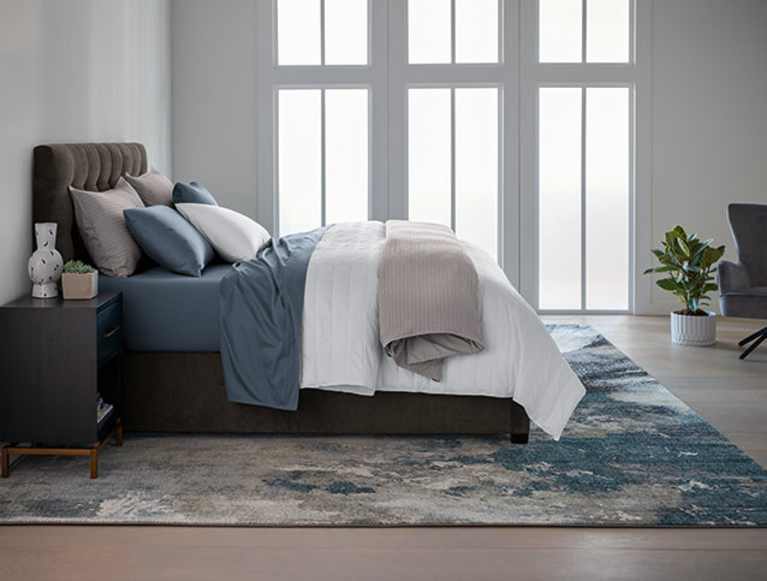
What you put on your bed can hinder or enhance your sleep quality. Believe it or not, your bedding may be to blame for your nighttime sweats and chills.
Self-proclaimed hot sleeper Kristen Hicks makes reducing heat at night a priority, otherwise she can’t sleep.
"It's less about when I crawl into bed though and more about getting hot or staying comfortable throughout the night," she notes.
If your evening ritual includes being mindful of temperature too, you're not alone. When it comes to how couples sleep, one of the largest factors is sleep temperature. In fact, 80% of couples report one or both partners sleep too hot or cold.* To help, people might change the thermostat, open a window, or turn on a fan for a cooling breeze. But, bedding also plays a role.
Let's learn how temperature affects our sleep and explore the best bedding choices for those of you who sleep too hot or too cold — so you can finally snooze at a temperature that feels just right.
Does Temperature Actually Affect Your Sleep?
Yes! The body is happiest when it's in a state of being "thermally neutral". This means it doesn't need to release heat via sweating or create warmth via shivering. It's the sweet spot for sleep. You can help create this ideal environment by setting your thermostat between 65 to 67 degrees.
"I start out with the down comforter pulled all the way up to my chin because I like the comfort of it. Usually in the night I go back and forth with the bedding on and off depending on how bad the night sweats get," explains Margo Leisinger, an Iowa resident who creates a cool sleeping environment by using a fan and wearing lightweight pajamas.
When you or your bedroom are too cold or too hot at night, expect increased wakefulness, a decrease in REM sleep and slow wave sleep, according to a paper published in the Journal of Physiological Anthropology. In other words: YOU WAKE UP GROGGY AND TIRED and don't have as much energy as you'd like. High humidity affects sleep quality, too.
Discover how you can sleep at your ideal temperature with our True Temp™ bedding.
What Should You Have on Your Bed for Better Sleep?
For many of us, picking out pillows and bed covers focuses on colors or patterns that coordinate with bedroom décor. We challenge you to go one step further and consider the quality and type of bedding you're using if you have trouble finding the right sleep temperature.
Temperature-balancing bedding can absorb excess body heat. It works to keep you warm as you fall asleep, then provides cooling to help you stay asleep without the need for adjustments at night. Yes, smart bedding is a thing, and it's awesome. Among new customers who purchased a temperature balancing solution product from Sleep Number, 8 out of 10 report they and their sleep partner are now sleeping better.
So, let's make the bed — with temperature in mind:
-
Pillows: A cool pillow is a must for many, choose pillows that help regulate your temperature at night. True Temp™ adapt pillows remove moisture vapor to resist heat and humidity buildup. A cool-to-the touch cover is combined with soft fiberfill and supportive foam for maximum comfort. Take the Sleep Number® PillowFit® quiz to find the perfect one for you.
-
Sheets: If your bed feels too warm at night or if you flux between hot and cold, or have a partner with the opposite temperature preference as you, try the True Temp™ sheet set for equalized comfort all night long.
-
Mattress Cover: Select a pad for below your sheets that helps regulate temperature. The True Temp™ plush mattress layer is a fitted cover that wicks away heat and humidity (Take that, night sweats!). It keeps you cooler at night when your body temperature is on the rise.
-
Blankets: If you bundle up for bed and still find it hard to fall asleep, get extra cozy with a plush blanket that’s soft and cozy for year-round warmth. Or, consider a temperature balancing True Temp™ blanket that attracts and removes moisture to reduce heat and humidity build-up in bed. This is especially important for plush-loving blanket owners. "We sleep under the blankets. I like the blankets pulled up to my cheekbone," says Nikki Purucker, a Nebraska woman who prefers warmth head-to-toe when she lies down for the night.
-
Pets: Okay, so these don't fit into bedding category, strictly speaking — but if they are on your bed each night, are they hindering your sleep by adding extra warmth? Dog book author and psychology professor Stanley Coren, PhD., DSc., FRSC says in a Psychology Today article that having a pet in the bed can create psychological comfort, but it can also be a source of heat. A dog's normal body temp is 104 degrees Fahrenheit, while a human's hovers around 98. If you're too hot at night, encourage pets to stay at the foot of the bed.
Like diet and exercise, quality sleep is essential for optimal wellbeing and performance. Because everyone's sleep needs are different, Sleep Number® smart beds sense your movements and automatically adjust firmness, comfort and support to keep you both sleeping comfortably. Find your Sleep Number® setting for your best possible night's sleep, and if you own a Sleep Number® bed, log in to your Sleep Number® Rewards account to see your exclusive offers, refer friends and more.
*Results from a 2020 Sleep Number survey of 1,004 respondents who reported they or their partner sometimes sleep too hot or too cold.